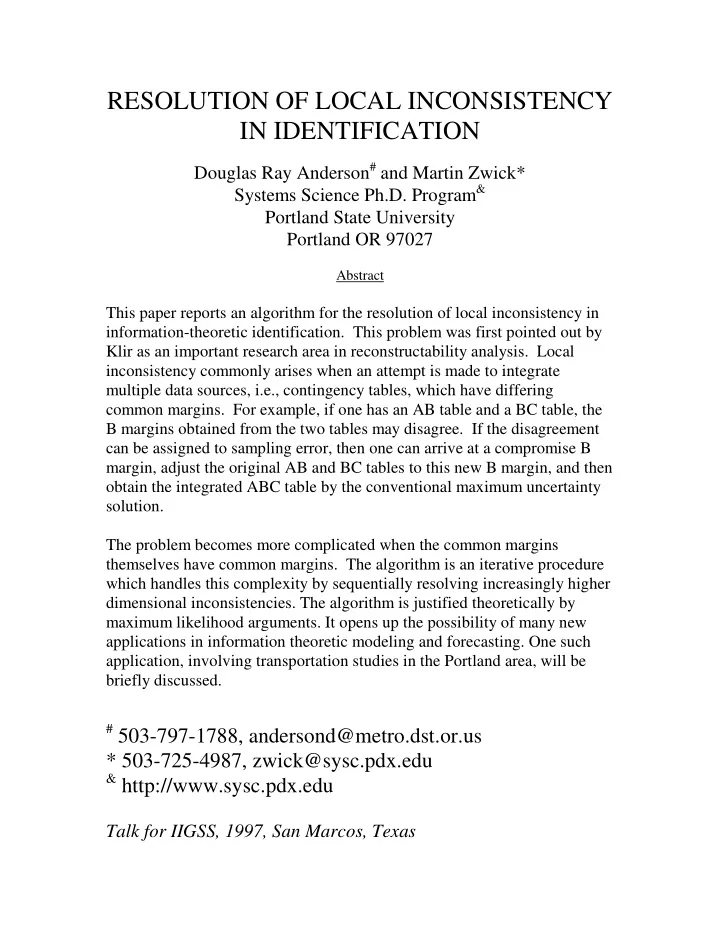

RESOLUTION OF LOCAL INCONSISTENCY IN IDENTIFICATION Douglas Ray Anderson # and Martin Zwick* Systems Science Ph.D. Program & Portland State University Portland OR 97027 Abstract This paper reports an algorithm for the resolution of local inconsistency in information-theoretic identification. This problem was first pointed out by Klir as an important research area in reconstructability analysis. Local inconsistency commonly arises when an attempt is made to integrate multiple data sources, i.e., contingency tables, which have differing common margins. For example, if one has an AB table and a BC table, the B margins obtained from the two tables may disagree. If the disagreement can be assigned to sampling error, then one can arrive at a compromise B margin, adjust the original AB and BC tables to this new B margin, and then obtain the integrated ABC table by the conventional maximum uncertainty solution. The problem becomes more complicated when the common margins themselves have common margins. The algorithm is an iterative procedure which handles this complexity by sequentially resolving increasingly higher dimensional inconsistencies. The algorithm is justified theoretically by maximum likelihood arguments. It opens up the possibility of many new applications in information theoretic modeling and forecasting. One such application, involving transportation studies in the Portland area, will be briefly discussed. # 503-797-1788, andersond@metro.dst.or.us * 503-725-4987, zwick@sysc.pdx.edu & http://www.sysc.pdx.edu Talk for IIGSS, 1997, San Marcos, Texas
1. IDENTIFICATION UNDER LOCAL INCONSISTENCY PROBLEM: RESOLVING LOCAL INCONSISTENCY AMONG PROJECTIONS 2. CONFORM ALGORITHM METHOD: OBTAIN COMPROMISE MARGINS WHICH MINIMIZE ERROR 3. APPLICATION RESULTS: TRANSPORTATION MODELING & FORECASTING
1. IDENTIFICATION UNDER LOCAL INCONSISTENCY PROBLEM: RESOLVING LOCAL INCONSISTENCY AMONG PROJECTIONS • THE IDENTIFICATION PROBLEM • EXAMPLE & ITS SOLUTION • EQUATIONS • IDENTIFICATION WITH LOCAL INCONSISTENCY • EXAMPLE & ITS SOLUTION • EQUATIONS • GLOBAL INCONSISTENCY 2. CONFORM ALGORITHM METHOD: OBTAIN COMPROMISE MARGINS WHICH MINIMIZE ERROR 3. APPLICATION RESULTS: TRANSPORTATION MODELING & FORECASTING
1. IDENTIFICATION UNDER LOCAL INCONSISTENCY PROBLEM: RESOLVING LOCAL INCONSISTENCY AMONG PROJECTIONS 2. CONFORM ALGORITHM METHOD: OBTAIN COMPROMISE MARGINS WHICH MINIMIZE ERROR • IRRESOLVABLE LOCAL INCONSISTENCY • BASIC OPERATIONS OF CONFORM • SOLUTIONS WITH & WITHOUT CLAMPING • COMPARISON WITH ARBITRARILY CHOOSING A PROJECTION • CONFORM EQUATIONS • CONFORM ALGORITHM • POST-TEST OF CONFORM RESULTS 3. APPLICATION RESULTS: TRANSPORTATION MODELING & FORECASTING
1. IDENTIFICATION UNDER LOCAL INCONSISTENCY PROBLEM: RESOLVING LOCAL INCONSISTENCY AMONG PROJECTIONS 2. CONFORM ALGORITHM METHOD: OBTAIN COMPROMISE MARGINS WHICH MINIMIZE ERROR 3. APPLICATION RESULTS: PORTLAND TRANSPORTATION MODELING & FORECASTING • THREE MAJOR USES OF THIS METHODOLOGY • TRANSPORTATION MODELING VARIABLES • SPECIFIC MODELING TASKS • MODELING EXPERIMENTS
THREE MAJOR USES OF THIS METHODOLOGY THE GENERAL IDEA 1. INTEGRATE DATA FROM DIFFERENT SOURCES, EVEN WHEN CONTRADICTORY . e.g., AB + BC → ABC (ABC has structure AB:BC) CLAMPING OPTIONAL. 2. OBTAIN HIGHER ORDER STRUCTURE WITH SUPPLEMENTARY VARIABLES. e.g., ABT + BCT → ABCT → ABC (full ABC structure) CLAMPING OPTIONAL. 3. USE CROSS-TABULATIONS FOR FORECASTING . E.G., A B + A f → A f B f → B f . B IS NOT CLAMPED.
TRANSPORTATIONAL MODELING VARIABLES PORTLAND TRIP GENERATION BASED ON FOLLOWING VARIABLES: H: HOUSEHOLD SIZE I: INCOME A: AGE OF HOUSEHOLDER Z: GEOGRAPHIC ZONE SUPPLEMENTARY VARIABLES T: TENURE (OWN VS. RENT) “NUISANCE VARIABLE” U: # UNITS IN RESIDENCE STRUCTURE “DRIVING VARIABLE”
SPECIFIC MODELING TASKS INVOLVING RESOLUTION OF LOCAL INCONSISTENCIES 1. INPUT: PROJECTIONS of H I A Z or of H I A Z T METHOD: CLAMPING OPTIONAL OUTPUT: H I A Z USE: # 1 (INTEGRATION) + #2 (HIGHER STRUCTURE) PURPOSE: CALIBRATE TRANSPORTATION SIMULATIONS 2. INPUT: H I A Z and A f , Z f or A f , (ZU) f METHOD: NO CLAMPING OUTPUT H f I f A f Z f , i.e., PREDICT ( H I ) f USE: #3 (FORECASTING) PURPOSE: ESTIMATE FUTURE DEMAND
MODELING EXPERIMENTS DIFFERENT MODELING EXPERIMENTS: INPUTS OUTPUTS FORECAST VAR. 1 HZ, IZ, AZ HZ:IZ:AZ A,Z 2 HZ, IZ, AZ, HA, IA HZ:IZ:AZ:HA:IA A,Z 3 HZT, IZT, AZT, HAT, IAT HIAZ A,Z 4 HZT, IZTU, AZT, HAT, IAT HIAZU A, ZU ENRICHING STRUCTURE OF HIAZ: 3: HAT:IZT: IAT:HZT: AZT → HIAZT → HIAZ 4: HAT:IZTU: IAT:HZT: AZT → HIAZTU → HIAZU THE DIFFERENCE BETWEEN 3 & 4 IS ONLY IN FORECAST MODEL PERFORMANCE MODEL ASSOC. FOR HI, HA, IA ERROR 1 NO, NO, NO 30 2 NO, YES, YES 17 3, 4 YES, YES, YES NOT YET AVAILABLE ERROR (EMPIRICAL) = WORST DIFFERENCE FROM LINE COUNTS
Recommend
More recommend